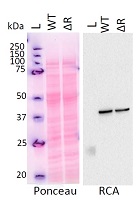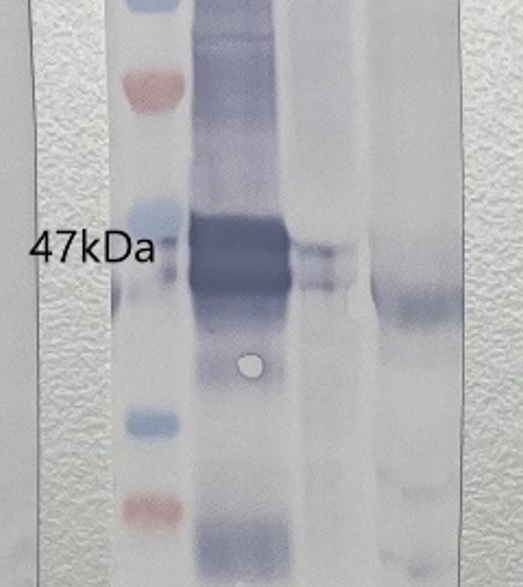1

Anti-RA | Rubisco activase
AS22 4868 | Clonality: Polyclonal | Host: Rabbit | Reactivity: Arabidopsis thaliana, Chlamydomonas reinhardtii, Hordeum vulgare
- Product Info
-
Immunogen: Purified, recombinant Rubisco activase from Gossypium hirsutum Q9AXG1
Host: Rabbit Clonality: Polyclonal Purity: Immunogen affinity purified serum in PBS pH 7.4. Format: Lyophilized Quantity: 50 µg Reconstitution: For reconstitution add 50 µl of sterile water Storage: Store lyophilized/reconstituted at -20°C; once reconstituted make aliquots to avoid repeated freeze-thaw cycles. Please remember to spin the tubes briefly prior to opening them to avoid any losses that might occur from material adhering to the cap or sides of the tube. Tested applications: Western blot (WB) Recommended dilution: 1: 5000 (WB) Expected | apparent MW: 47 and 42 kDa (maize, tobacco, Chlamydomonas) - Reactivity
-
Confirmed reactivity: Arabidopsis thaliana, Chlamydomonas reinhardtii, Hordeum vulgare
Predicted reactivity: Camelina sativa, Caesalpinia pulcherrima, Glycine max, Gossypium mexicanum, Hordeum spontaneum, Festuca pratensis, Glycine max, Gossypium hirsutum, Gossypium barbadense, Lolium perenne, Medicago sativa, Nannochloropsis oceanica, Nicotiana tabacum, Oryza sativa, Olea europea, Picea sitcHensis, Physcomitrium patens, Populus balsamifera, Ricinus communis, Solanum lycopersicum, Spinacia oleracea, Triticum aestivum, Rhoeo discolor, Solanum lycopersicum,Thellungiella salsuginea, red sulfur bacterium Thiodictyon sp. Cad16 (isolated from Lake Cadagno), Zea mays, Vitis vinifera
Species of your interest not listed? Contact usNot reactive in: marine picocyanobacteria - Application Examples
-

4 µg/well of total protein extracted from exponentially grown Chlamydomonas reinhardtii. Exact buffer components were: 0.1M Na2CO3, 0.1M DTT and denatured with 2% SDS-5% Sucrose at 100 °C/1 min. Samples were separated on 8-16% SDS-PAGE and blotted for 1 h to nitrocellulose (pore size of 0.1 um), using: semi-dry transfer at RT. Blot was blocked with 5 % milk for 1h/RT with agitation. Blot was incubated in the primary antibody at a dilution of 1: 1000 and 1/5000 in TBS-T for ON/4°C with agitation. The antibody solution was decanted and the blot was rinsed briefly twice, then washed once for 15 min and 3 times for 5 min in TBS-T at RT with agitation. Blot was incubated in matching secondary antibody (anti-rabbit IgG horse radish peroxidase conjugated, AS09 602) diluted to 1: 25 000 in TBS-T for 1h/RT with agitation. The blot was washed as above and developed with a following chemiluminescent detection reagent: AgriseraBright (Agrisera). Exposure time was respectively 15s and 40s.
Courtesy of Dr. Katia Wostrikoff, CNRS/Sorbonne, France

Samples from left to right:
1 – MW marker
2 – 10µg of Arabidopsis thaliana whole leaf extract
3 – 10µg of Hordeum vulgare whole leaf extract
4 – 10µg Chlamydomonas reinhardtii whole cell extract10 µg/well of respective cell extract was denatured with Invitrogen LDS sample buffer (4X) at 70°C/5 min. Samples were separated on Invitrogen NuPage Bis-Tris 4-12% SDS-PAGE 45min and blotted for 1 h to Invitrogen PVDF (pore size of 0.45 um), using: wet transfer. Blot was blocked with 5% milk in TBS-T for: 1h/RT with agitation. Blot was incubated in the primary antibody at a dilution of 1: 1000 for 1h/RT with TBS-T Blocking. The antibody solution was decanted, and the blot was rinsed briefly twice, then washed once for 10 min and 2 times for 5 min in TBS-T at RT with agitation. Blot was incubated in matching secondary antibody (anti-rabbit IgG ALP conjugated, AS09 607 lot 2105 ) diluted to 1: 5 000 in TBS-T Blocking for 0,5h/RT with agitation. The blot was washed as above and developed with AS19 BCIP-NBT lot 03068231 for 0.5-3min. Image was captured after 2h.
- Additional Information
-
Additional information (application): There are two forms of activase (alpha and beta) in some species (for example Arabidopsis, camelina, spinach, rice) and only one form in other species (tobacco, maize, Chlamydomonas). Alpha is about 46-47 Kda, beta is about 42 kDa. Species that have only one form have the beta form. - Background
-
Background: RA - Ribulose bisphosphate carboxylase/oxygenase activase is an enzyme localized to chloroplasts which activates Rubisco by promoting ATP-dependent conformational changes. Alternative name: RuBisCo activase RCA.
- Product Citations
-
Selected references: 38221900 - Protocols
-
Agrisera Western Blot protocol and video tutorials
Protocols to work with plant and algal protein extracts
Agrisera Educational Posters Collection
- Reviews:
-
This product doesn't have any reviews.
Accessories

AS03 037 | Clonality: Polyclonal | Host: Rabbit | Reactivity: global antibody and compartment marker for higher plants, lichens, algae, cyanobacteria, dinoflagellates, diatoms
Benefits of using this antibody


